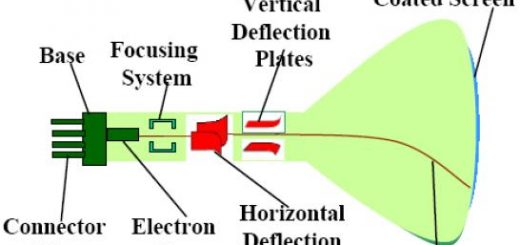Magnetic force and Torque, Factors that affect the torque and magnetic dipole moment
Fleming’s left hand rule is used to determine the direction of the magnetic force acting on a straight wire carrying an electric current placed perpendicular to a magnetic field, Let the pointer & thumb be perpendicular to each other and to the rest of the fingers then make the pointer point to the direction of the magnetic flux and the rest of the fingers except the thumb in the direction of the current, then the thumb points to the magnetic force or motion.
The force due to the magnetic field acting on a straight wire carrying electric current
If a straight wire carrying an electric current is placed between the poles of a magnet such that the wire is perpendicular to the magnetic flux lines:
The wire is acted upon by a force that is perpendicular to both the wire and the field, because of the change in the resultant of the magnetic flux density at the two sides of the wire which is due to the original magnetic flux and the magnetic flux due to the flow of the electric current in the wire.
This force leads to the motion of the wire from the high magnetic flux density to the low magnetic flux density if the wire is free to move.
We can reverse the direction of the force and also the direction of motion of the wire using one of the following methods:
- Reverse the direction of the electric current passing through the wire.
- Reverse the direction of the magnetic field acting on the wire.
Deduction of the magnetic force acting on a straight wire carrying an electric current in a magnetic field
It is found that the force acting on a straight wire of length (L) carrying electric current (I) flowing perpendicular to a magnetic field of flux density (B) depends on the following factors:
The length of the wire, F ∝ L
The current intensity, F ∝ I
The magnetic flux density, F∝ B
F∝ B I L, F = Constant × B I L
If the measuring unit of the magnetic flux density (B) is Tesla, then a 1 m long wire carrying a current of 1 A is affected by a force of 1 N.
F = B I L
If the wire makes an angle with the flux, so, the relation becomes:
F = B I L sin θ
If the wire is parallel to the direction of the flux lines, F = B I L sin 0 = 0, So, the force vanishes.
If the wire is perpendicular to the direction of the flux lines, F = B I L sin 90 = B I L, So, the force is maximum.
If the wire is perpendicular to the field lines, so, the magnetic flux density is determined by the relation B = F / IL.
So, we can define the magnetic flux density and its measuring unit (Tesla) as follows:
Magnetic flux density (B) is the magnetic force acting on a wire of length 1 m carrying electric current of intensity 1 A flowing perpendicular to the magnetic field at that point.
Tesla is the magnetic flux density, which exerts a force of one Newton on a wire of one-meter length carrying electric current of one Ampere perpendicular to the magnetic flux lines.
When the magnetic flux density at a point = 0.4 T, It means that the force acting on a wire of length 1 m carrying current of intensity 1 A flowing perpendicular to a magnetic field at that point = 0.4 N.
The factors that affect the magnetic force acting on a wire carrying current moving in a magnetic field normal to that wire.
- The magnetic flux density (B) is directly proportional.
- Length of the wire (l) is directly proportional.
- The electric current intensity (I) is directly proportional.
- Sine the angle between the wire and the direction of the flux (sin θ) is directly proportional.
If a wire carrying electric current is balanced horizontally in a magnetic field and perpendicular on it:
F = Fg
B I L = mg
B I L = ρ Vol g
B I L = ρ A L g
BI = ρ π r² g
The force between two parallel wires each carrying current
When a current I1 passes in a wire of length (L) and a current I2 passes in another parallel wire at a distance (d) and of the same length then the magnetic field around each wire acts on the other wire a force:
The force acting on the first wire (F1)
Resulting from the magnetic field of the second wire:
F1 = B2 I1 L = μ I2 I1 L / 2π d
∴ F1 = F2 = F = μ I1 I2 L / 2π d
Where: F is the mutual force between the wires.
If I1 and I2 in the same direction so, the mutual force is attraction force, because the resultant of the flux density outside the wires is greater than it is between the wires, so, a magnetic force is produced and it moves the two wires from the high-density region (outside) to the lower density region (inside), so they attract.
The force acting on the second wire (F2)
Resulting from the magnetic field of the first wire:
F2 = B1 I2 L = μ I1 I2 L / 2π d
∴ F1 = F2 = F = μ I1 I2 L / 2π d
Where: F is the mutual force between the wires.
If I1 and I2 in the opposite direction so, the mutual force is repulsion force because resultant of flux density between the wires is greater than it is outside them, so a magnetic force is produced and it moves the wires from the high-density region (inside) to the lower density region (outside), so they repel.
To determine the force by which two parallel wires 1, 2 act on a third wire parallel to them:
Calculate the produced magnetic flux density due to the first wire at the third wire position:
B13 = μ I1 / 2π d13
Calculate the produced magnetic flux density due to the second wire at the third wire position:
B23 = μ I2 / 2π d23
Calculate the resultant magnetic flux density: Bt = B13 + B23
Calculate the resultant force: F = Bt I3 L3
Deduction of the torque acting on a rectangular coil carrying electric current placed in a magnetic field
If a rectangular coil ( abcd ) carrying electric current is placed in a uniform magnetic field such that its plane is parallel to the lines of uniform magnetic flux.
The sides (ad) and (bc) are parallel to the flux lines, thus the force acting on each wire is zero.
The sides (ab) and (cd), are perpendicular to the flux lines, So, they will be acted upon by two forces equal in magnitude and opposite in direction, each equal F = B I Lcd.
Thus, the coil is acted upon by a torque which will cause the coil to rotate around its axis.
The torque is equal to one of the forces × perpendicular spacing between the two equal forces:
τ = B I Lcd Lbc = B I A
Where: (A) is the area of the rectangle A = Lcd Lbc, if the rectangle consists of (N) turns, the total torque (τ).
τ = B I A N
If the plane of the coil is inclined by an angle (θ) to the magnetic flux:
τ = B I A N sin θ
The measuring unit of the torque is Newton.meter (N.m).
If the plane of the coil is perpendicular to the direction of the magnetic flux, So, the perpendicular on the coil is parallel to the field.
τ = B I A N sin 0 = 0
So, The torque is zero.
If the plane of the coil is parallel to the direction of the magnetic flux lines, So, the perpendicular on the coil is perpendicular on the field.
τ = B I A N sin 90 = B I A N
So, The torque is the maximum value.
τ = B md , md = I A N = τ / B
Where: md = I A N is the magnetic dipole moment which is a vector quantity and its direction is perpendicular to the area of the coil in the direction of advancing of a right-hand screw, which is the direction of the electric current.
The magnetic dipole moment md is the torque acting on a coil carrying electric current and its plane is parallel to a magnetic flux density of 1 T.
The measuring unit of the magnetic dipole moment is (N.m/T) (Newton.meter/Tesla) which is equivalent to Ampere.m² (A.m²).
When the magnetic dipole moment = 0.7 N.m/T, It means that the torque acting on a coil carrying an electric current and its plane is parallel to a magnetic flux density of 1 T equals 0.7 N.m.
The factors that affect the torque
- Magnetic flux density is directly proportional.
- The surface area of the coil (A) is directly proportional.
- The number of turns of the coil (N) is directly proportional.
- Current intensity (I) is directly proportional.
- Sine the angle between the perpendicular on the plane of the coil and the magnetic flux lines (sin θ) is directly proportional.
The factors that affect the magnetic dipole moment
- Electric current intensity (I) is directly proportional.
- The surface area of the coil (A) is directly proportional.
- The number of turns of the coil (N) is directly proportional.
The magnetic field due to current in a circular loop and a solenoid
Magnetic effect of the electric current & Magnetic flux density due to current in two parallel wires
Sensitive moving coil galvanometer, Direct current ammeter & Ammeter sensitivity













